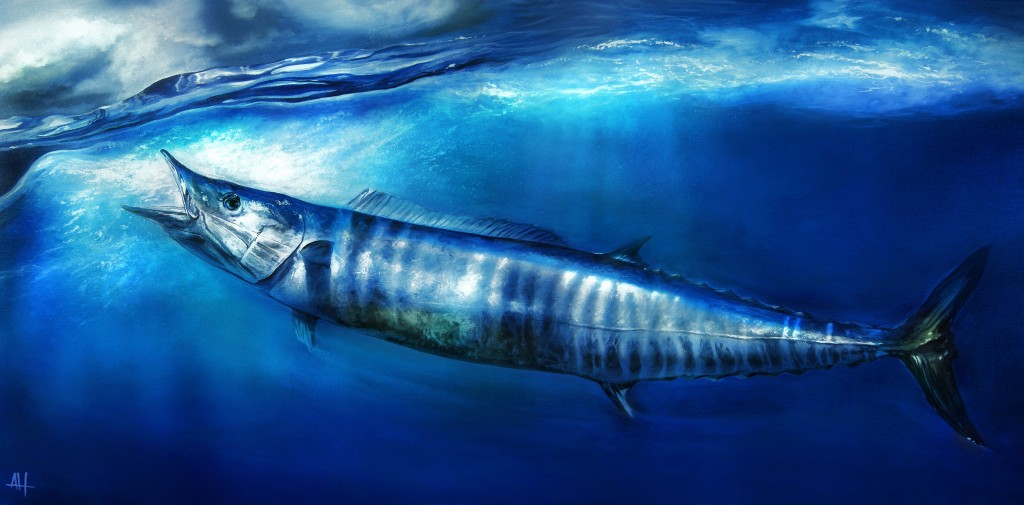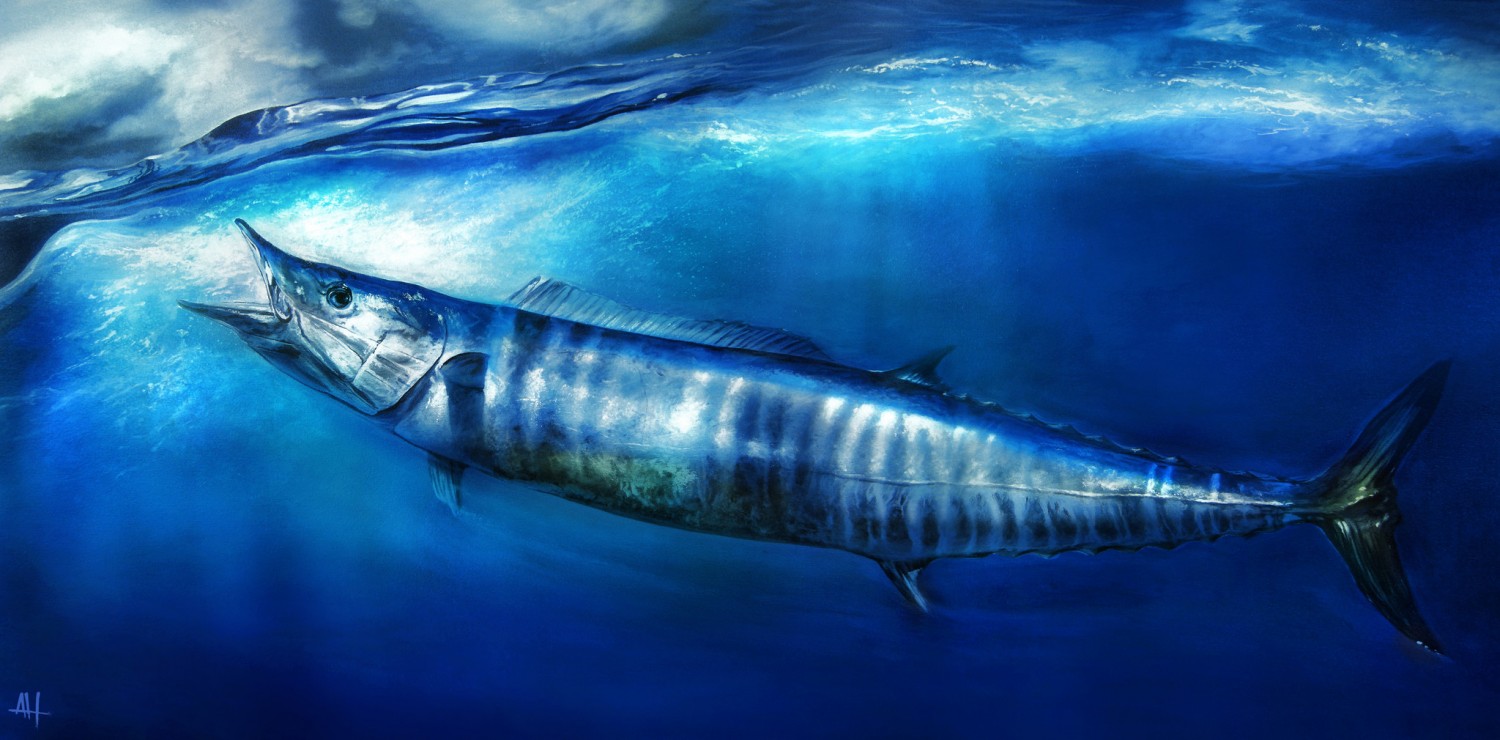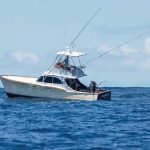Wahoo (Acanthocybium solandri) is a scombrid fish found worldwide in tropical and subtropical seas. It is best known to sports fishermen, as its speed and high-quality flesh make it a prize game fish. In Hawaii, the wahoo is known as ono. Many Hispanic areas of the Caribbean and Central America refer to this fish as peto.
The flesh of the wahoo is white to grey, delicate to dense, and highly regarded by many gourmets. The taste is similar to mackerel, though arguably less pronounced. This has created some demand for the wahoo as a premium-priced commercial food fish. In many areas of its range, such as Hawaii, Bermuda and many parts of the Caribbean, local demand for wahoo is met by artisanal commercial fishermen, who take them primarily by trolling, as well as by recreational sports fishermen who sell their catch.

Image above ©Ashton Howard Fine Art
Description
Its body is elongated and covered with small, scarcely visible scales; the back is an iridescent blue, while the sides are silvery, with a pattern of irregular vertical blue bars and have razor sharp teeth. These colors fade rapidly at death. The mouth is large, and both the upper and lower jaws have a somewhat sharper appearance than those of king or Spanish mackerel.
Specimens have been recorded at up to 2.5 m (8 ft 2 in) in length, and weighing up to 83 kg (183 lb).Growth can be rapid. One specimen tagged at 5 kg (11 lb) grew to 15 kg (33 lb) in one year. Wahoo can swim up to 60 mph (97 km/h).They are some of the fastest fish in the sea.
The wahoo may be distinguished from the related Atlantic king mackerel and from the Indo-Pacific narrow-barred Spanish mackerel by a fold of skin which covers the mandible when its mouth is closed. In contrast, the mandible of the king mackerel is always visible as is also the case for the smaller Spanish mackerel and Cero mackerel. The teeth of the wahoo are similar to those of king mackerel, but shorter and more closely set together.
The barracuda is sometimes confused with mackerel and wahoo, but is easy to distinguish from the latter two species. Barracuda have prominent scales, larger, dagger-like teeth, and lack the caudal keels and blade-like tail characteristic of the scombrid (mackerel)
Biology
Wahoo tend to be solitary or occur in loose-knit groups of two or three fish, but where conditions are suitable can be found in schools as large as 100 or more. Their diet is made up of other fish and squid.
Most wahoo taken have a trematode parasite living in their stomachs, the giant stomach worm (Hirudinella ventricosa), which does not appear to harm the fish.
Fisheries
Commercial
Although local wahoo populations can be affected by heavy commercial and sports fishing pressure, wahoo as a species are less susceptible to industrial commercial fishing than more tightly schooling and abundant species such as tuna. Wahoo are regularly taken as a bycatch in various commercial fisheries, including longline fisheries for tuna, billfish, and dolphinfish (mahi-mahi or dorado) and in tuna purse seine fisheries, especially in sets made around floating objects, which act as a focal point for a great deal of other marine life besides tuna. In 2003, the South Atlantic Fishery Management Council issued a Dolphin Wahoo Fishery Management Plan for the Atlantic.However, the species as a whole is not considered overfished.
Recreational
In most parts of its range, the wahoo is a highly prized sport fishing catch. It reaches a good size, is often available not too far from land, and is a very good fighter on light to medium tackle. It is known in sports fishing circles for the speed and strength of its first run. The aggressive habits and razor-sharp teeth of the wahoo can be of considerable annoyance when targeting larger gamefish, however, such as tuna or marlin.
- Wahoo are related to mackerels and are members of the fish family Scombridae.
- Wahoo live in tropical and subtropical waters worldwide. During the summer, they may migrate into temperate waters.
- According to the International Game Fish Association, the official record (http://www.igfa.org) for the largest wahoo caught on hook and line is 158.5 lb (71.9 kg). However, uncertified reports indicate wahoo may grow as large as 200 lb (91 kg) or more.
- Wahoo tend to be solitary, but they are occasionally found in small, loose schools.
- Wahoo is a prized game fish due to its speed, fighting qualities, and excellent flavor.
- Wahoo are among the fastest pelagic species (reaching speeds up to 60 mph) and are capable of capturing a wide range of prey, including various fishes and squid.
- Wahoo are thought to be relatively fast growing. In one study, a wahoo that was tagged, released, and recovered ten months later had grown around 22 pounds in less than a year-from 11 lb (5 kg) to 33 lb (15 kg).
- The giant stomach worm (Hirudinella ventricosa) is commonly found in wahoo stomachs, but the worm does not affect the portion of the fish eaten by humans.
- Wahoo have been included in the FWC-FWRI Mercury Program, which investigates total mercury levels in the muscle tissue of various Florida fishes. The Florida Department of Health (http://www.doh.state.fl.us/) has issued a health advisory for wahoo in the Florida Keys and Florida Bay regions.
- Wahoo are currently the topic of much scientific research in Florida. Scientists at the Fish and Wildlife Research Institute are studying wahoo biology. Scientists at Florida Atlantic University are conducting a genetic study to investigate the relationship between individual wahoo from different parts of the world.
- A recently approved management plan, developed by the South Atlantic Fishery Management Council (http://www.safmc.net) in conjunction with the Mid-Atlantic and New England councils, will set limits on commercial and recreational dolphin and wahoo catches in federal waters along the entire Atlantic coast.
This article was put together with information gathered from Wikipedia and from myfwc.com






